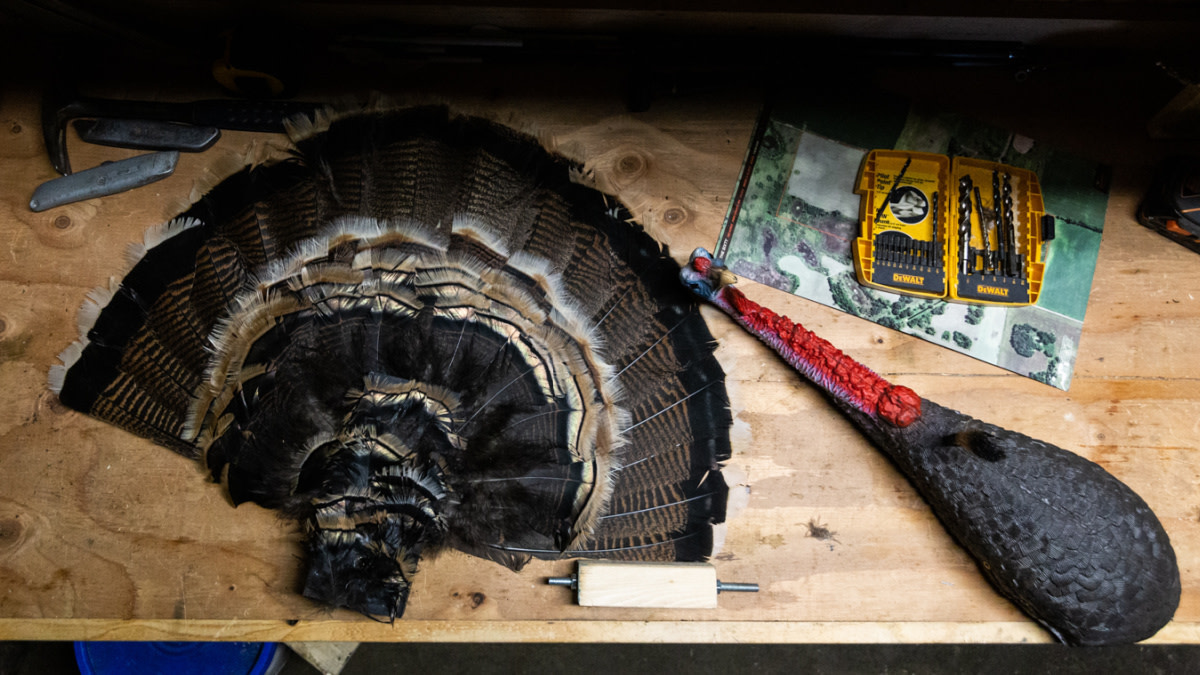
The beauty of spring turkey hunting is that success can be achieved through multiple hunting styles. You can run-and-gun with a shotgun or set up shop in a hub-style blind with your bow. You can crawl around and bushwhack them, or put out a whole spread of decoys and only take the safety off when a gobbler struts in to put on a show. Or you can reap.
Reaping is the act of crawling into a longbeard’s guard and popping up a fan or a decoy built specifically for the task. It’s exciting, but it can also be dangerous. In states that allow center-fire rifles for spring birds, it’s a nonstarter. Don’t do it. And on public land east of the Missouri River, forget it. This is simply too risky to pull off in places where you might encounter other hunters.
This also goes without saying, but make sure reaping is legal in your state. For safety reasons, some places in the East and South don't allow hunters to reap.
Matt Mancl, a member of the Breaking Point TV crew, waits for a very specific reaping scenario to unfold before he gets out the fan.
“We always look for a spot where a conventional setup isn’t going to happen, like when the birds are out in a CRP field or a big hayfield and the terrain will allow us to sneak within 100 yards. Then, if it’s a safe setup, we’ll get serious about reaping.”
It’s the getting close part Mancl references that a lot of first-time reapers don’t quite understand. “The closer you get, the more uncomfortable they get,” Mancl said.
If you’re too far away, a bird has time to think things through and gather up his hens. When you show up close, he almost has no choice but to confront the decoy as long as he hasn’t spotted something fishy.
“There are a lot of oversized reaping decoys out there, but we prefer to stay small and as non-threatening as possible,” Mancl said. “You do want to block your body with the fan while crawling in but try to keep your whole setup looking like the least intimidating jake or tom possible.”
This is a great way to make a move on a hunter-savvy bird that thinks he’s safe in the middle of a grasshopper-filled hayfield, especially for the shotgun hunter. Getting within a football field of that bird undetected and then showing him a rival isn’t a surefire way to get him close, but it works often enough that it’s worth the gamble.
Bowhunters can reap too, but they’ve got to think about things a little differently. Handling a bow and a fan, or bigger reaping decoy, is a pain in general. It’s even worse when you have to belly crawl for 250 yards across the landscape. This is why Colorado bowhunting expert, Jace Bauserman opts for a bow-mounted option.
“I use decoys, like the shoot-through Ultimate Predator models,” Bauserman said. “I can mount them to my bow and keep them straight out and looking as natural as possible when I’m moving. This also applies to the moment when I draw because I never want the bird to see anything wonky, like the decoy suddenly leaning one way or the other.”
Having used a fair amount of bow-mounted decoys in my life, I’ll add to Bauserman’s comments that practicing with your chosen reaper is a necessity. You want to know what your sight window looks like, and how your bow handles the wind when it’s got a mini sail attached to it.
If you’re proficient and confident with your bow-mounted rig, Bauserman says you’ll also want to think about how you display it to a gobbler. Just like Mancl, he’s got a strategy for getting in close before the big reveal in order to hedge his bets on an aggressive response.
But Bauserman takes it a step further. “If it’s at all possible, I only show the toms a portion of the decoy like the very top of the fan. I’ll use available brushy cover and show only bits and pieces of the decoy.”
Bauserman’s theory is that the toms see flashes of a strutter and assume he’s either with a hen, or too much of a coward to step right out and square up for a fight. This technique will pique the interest of lone toms but is even deadlier on multiples.
Whether you bowhunt or gun hunt, reaping is an option worth consideration provided it’s safe and legal in your area. Remember that for most turkey hunters, reaping is an in-the-moment decision prompted by a bird that has decided to hang in no-man’s land. Those longbeards think they’re safe, which can work in your favor if you’ve got a turkey that’s in the right terrain and right mood.







